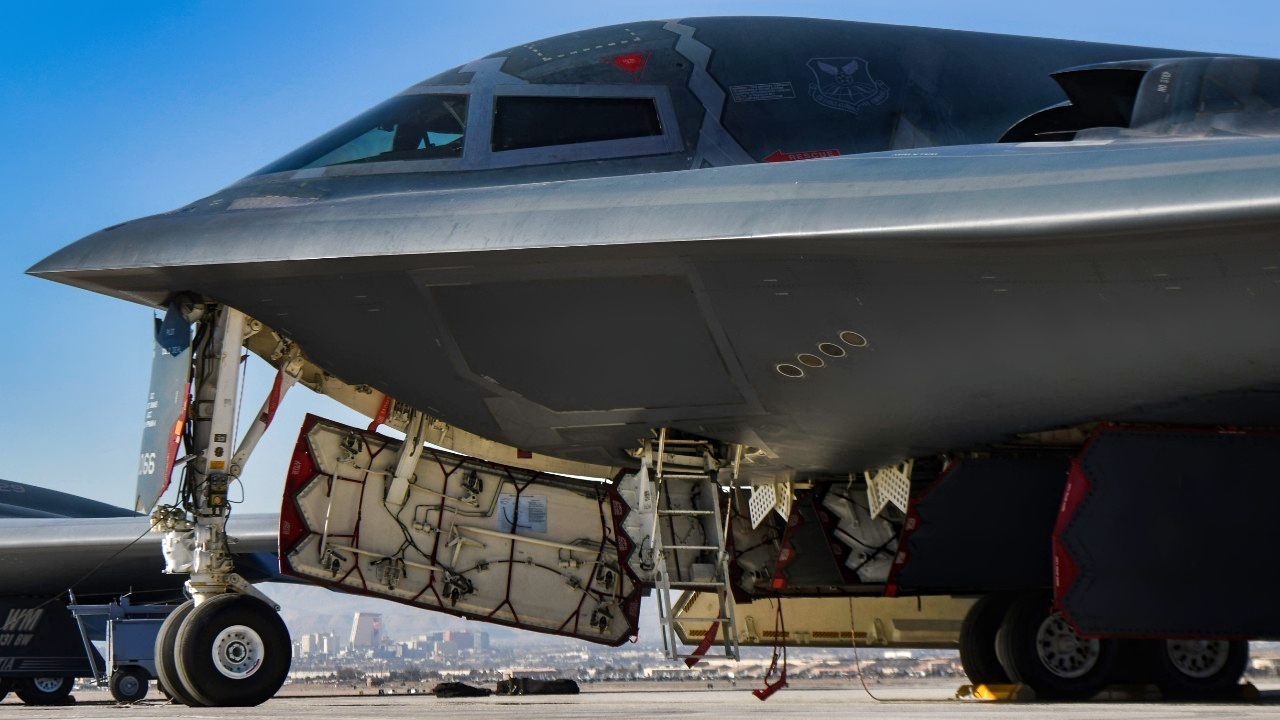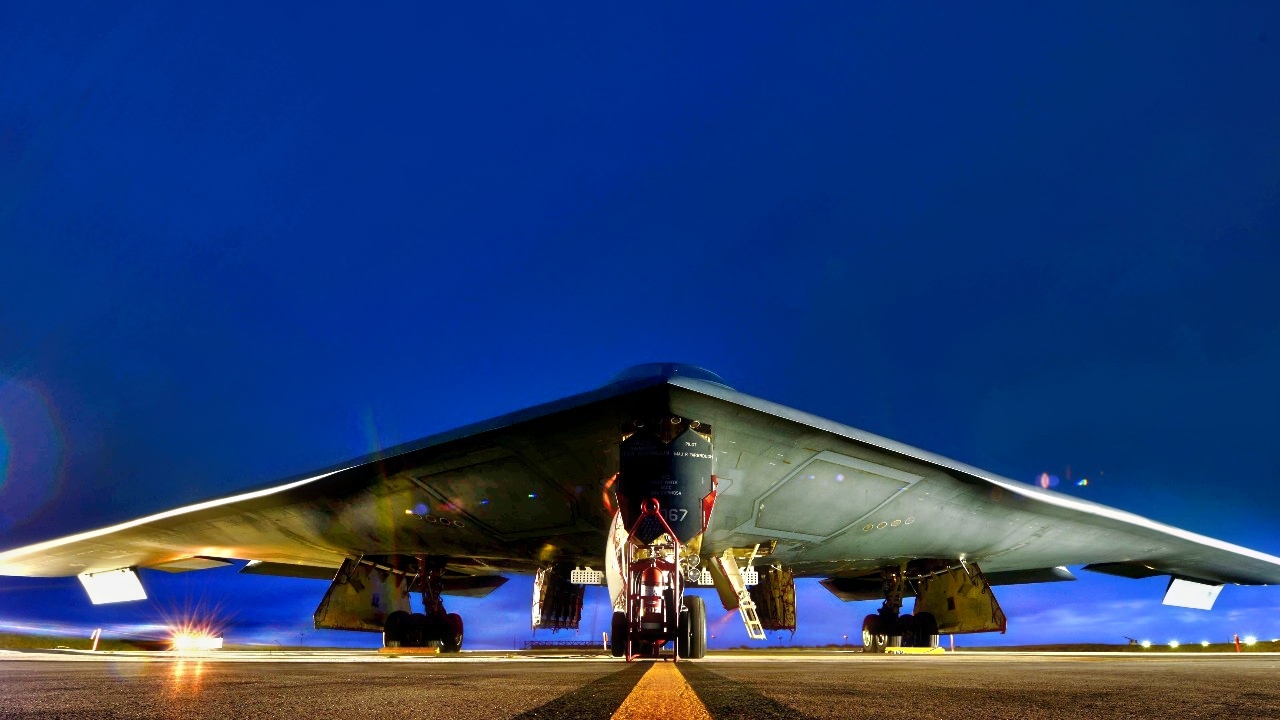Key Points and Summary on B-21 Raider’s Size – The new B-21 Raider is deliberately smaller than its B-2 predecessor, a design choice reflecting a major shift in strategic thinking.
-This more compact airframe is made possible by decades of advances in stealth technology, allowing for a lower radar cross-section without the B-2’s massive size.

Three Whiteman Air Force Base 393rd Expeditionary Bomb Squadron B-2 Spirit stealth bombers sit on the runway during Red Flag-Nellis 22-1 on Jan. 26, 2022, at Nellis Air Force Base, Nevada. Red Flag-Nellis 22-1 provides realistic combat training that saves lives by increasing combat effectiveness. (U.S. Air Force photo by Senior Airman Michael A. Richmond)
-The smaller design also makes the B-21 more affordable and sustainable, enabling the Air Force to procure a much larger fleet.
-It represents a move away from overwhelming payloads toward precision, network-centric warfare, and long-term adaptability with its open systems architecture, making it the future of American air power.
The B-21 Raider and the ‘Size’ Question
The B-21 Raider is America’s next-generation stealth bomber intended to replace the aging B-1 Lancer and B-2 Spirit. It is designed to penetrate deep into enemy territory and deliver highly lethal precision strikes using conventional or nuclear armaments. he B-21 is a product of the Long-Range Strike Bomber (LRS-B) program and reflects a significant evolution in bomber design, emphasizing stealth, survivability, and adaptability in modern combat environments.
Why the B-21 is Smaller Than the B-2
As information about the B-21 was released, analysts quickly noticed an interesting fact regarding the bombers size.
The B-21 is smaller than the B-2, and this is a deliberate design choice driven by several strategic and technological considerations. First and foremost, the B-21 benefits from decades of advancements in stealth technology. While the B-2 was revolutionary in its time, the B-21 incorporates newer materials, more efficient radar-absorbent coatings, and refined shaping techniques that allow it to maintain a low radar cross-section with a more compact airframe. This means the aircraft can be smaller without sacrificing its ability to evade detection by enemy radar systems.

A U.S. Air Force B-2 Spirit aircrafts deployed from Whiteman Air Force Base, Mo., sits on the parkway after landing from a local training flight at Andersen Air Force Base, Guam, Jan. 17, 2017. Close to 200 Airmen and three B-2s deployed from Whiteman Air Force Base, Mo., and Barksdale Air Force Base, La., in support of U.S. Strategic Command Bomber Assurance and Deterrence missions. USSTRATCOM units regularly conduct training with and in support of the Geographic Combatant Commands. USSTRATCOM, through its global strike assets, helps maintain global stability and security while enabling units to become familiar with operations in different regions. (U.S. Air Force photo by Tech. Sgt. Andy M. Kin)
Another reason for the B-21’s reduced size is cost efficiency. The B-2 was extremely expensive to build and maintain, with each unit costing over $2 billion when adjusted for inflation. Its maintenance, particularly the upkeep of its stealth coatings, was labor-intensive and costly. In contrast, the B-21 was designed with affordability and sustainability in mind.
By reducing the size of the aircraft, designers were able to lower material costs, decrease fuel consumption, and simplify maintenance procedures. The Air Force has set a target unit cost of approximately $550 million (in 2020 dollars), and the goal is to acquire at least 100 B-21s, making it a more scalable and economically viable platform.
Does this Affect Payload Capacity?
The B-21’s smaller size also reflects a shift in strategic doctrine. Modern warfare increasingly prioritizes precision over payload. Rather than relying on massive bomb loads, the B-21 is designed to deliver highly accurate munitions deep into enemy territory.
This approach reduces the need for the large payload capacity that characterized earlier bombers, such as the B-2. We don’t know the B-21’s full payload capacity yet but it is expected to carry up to 30,000 pounds of ordnance, which is smaller than the B-2’s payload capacity which can fit upwards of 40,000 pounds.
However, this reduction in payload does not equate to a decrease in effectiveness.
The B-21 is equipped to deploy a wide range of advanced munitions, including nuclear bombs like the B61 and B83, conventional precision-guided bombs such as JDAMs, and future weapons like the Long-Range Stand-Off (LRSO) missile and potentially hypersonic weapons.

The B-21 Raider program is on track and continues flight testing at Northrop Grumman’s manufacturing facility on Edwards Air Force Base, California. The B-21 will have an open architecture to integrate new technologies and respond to future threats across the spectrum of operations. The B-21 Long Range Strike Family of Systems will greatly enhance mission effectiveness and Joint interoperability in advanced threat environments, strengthening U.S. deterrence and strategic advantage. (U.S. Air Force photo)
In terms of design, the B-21 retains the flying wing configuration of the B-2 but incorporates several refinements. The aircraft features blended engine inlets and sharper cockpit angles to further reduce its radar signature. Its airframe is streamlined for stealth, with fewer moving parts and simplified landing gear to enhance reliability and reduce maintenance needs.
The B-21 also uses advanced radar-absorbent materials that are more durable and easier to maintain than those used on the B-2.
Size Matters Not
The B-21 was designed for an entirely different era of warfare; one dominated by technological advancement and network centricity. This design philosophy allows for rapid integration of new technologies and mission systems, ensuring that the aircraft can evolve to meet emerging threats.
The B-21 is also designed to be optionally manned according to some reports, meaning it can be flown with or without a crew depending on the mission requirements.
This capability positions the B-21 as a versatile platform that can adapt to a wide range of roles, including electronic warfare, intelligence gathering, and even unmanned strike missions in the future.
The B-21 is built to operate in highly contested environments, including those protected by advanced integrated air defense systems like those deployed by China and Russia.

The B-21 Raider was unveiled to the public at a ceremony December 2, 2022 in..Palmdale, Calif. Designed to operate in tomorrow’s high-end threat environment, the B-21 will play a critical role in ensuring America’s enduring airpower capability. (U.S. Air Force photo)
Its stealth capabilities, combined with its long range and precision strike ability, make it a critical asset for penetrating enemy defenses and delivering strategic effects.
The aircraft is also expected to play a key role in multi-domain operations, integrating with space, cyber, and ground-based assets to provide a comprehensive and coordinated response to threats.
The Next Generation of American Air Power
Despite sharing many characteristics with its predecessor, the B-2, there are several traits that distinguish them. The B-2 has a wingspan of 172 feet and a maximum takeoff weight of approximately 336,500 pounds.
In contrast, the B-21 is estimated to have a wingspan of around 140 feet and a maximum takeoff weight between 225,000 and 260,000 pounds. The B-2 is powered by four General Electric F118 engines, while the B-21 is expected to use two engines, likely variants of the Pratt & Whitney PW9000 or F135.
The B-2 requires a crew of two, and while the B-21 also has a two-person crew, it is designed to operate autonomously if needed.
MORE – A 7th Generation Fighter Could Fire Lasers
The B-2 entered service in 1997 and has been a cornerstone of the U.S. strategic bomber fleet. However, its high cost and maintenance demands have limited its deployment. Only 21 B-2s were built, and fewer than that remain in active service.
The B-21, by contrast, is intended to be produced in much larger numbers, with the Air Force planning to acquire at least 100 units. This larger fleet size, combined with the aircraft’s lower operating costs and greater adaptability, will ensure that the B-21 plays a central role in U.S. airpower for decades to come.
About the Author:
Isaac Seitz, a Defense Columnist, graduated from Patrick Henry College’s Strategic Intelligence and National Security program. He has also studied Russian at Middlebury Language Schools and has worked as an intelligence Analyst in the private sector.
The Best Tanks on Earth
AbramsX: The Tank the US Army Wants










